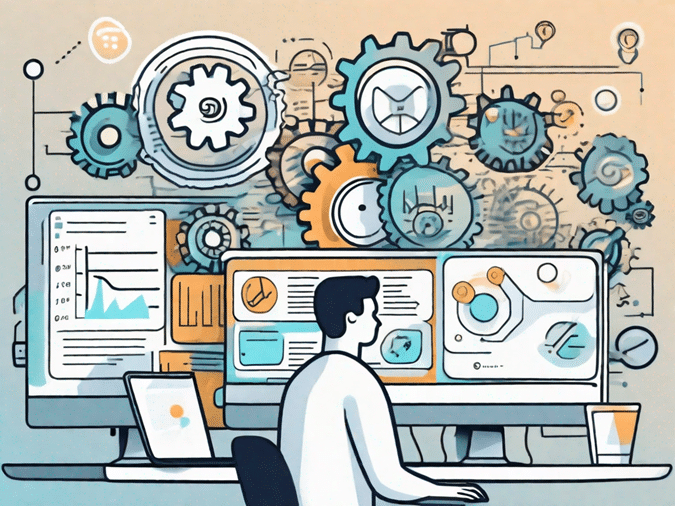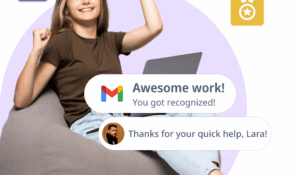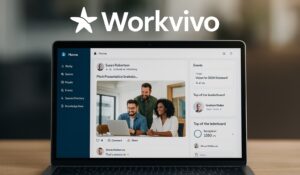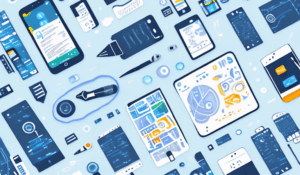We’ve seen organizations of every size struggle with one recurring challenge: employees spend too much time hunting for the information, tools, and HR resources they need. Whether someone is checking a policy, submitting a time-off request, or simply trying to stay updated, the experience is often fragmented across multiple systems.
That’s why many companies turn to an employee portal also known as a staff portal, HR portal, or employee self-service (ESS) portal. When implemented well, it becomes a single, intuitive hub that connects people to everything they need to work efficiently.
A good employee portal software can bring together HR tasks, payroll, benefits, internal communication, and daily workflows helping employees save time and stay informed while giving HR and IT teams a simpler, more scalable way to support the workforce.
👉 Learn how modern intranet software integrates all of this into one unified company hub.
What Is an Employee Portal?
An employee portal is a secure digital gateway that provides workers with access to company resources, HR services, tools, and communication channels.
Also known as:
- Staff portal → Often used in education and healthcare.
- Employee self-service (ESS) portal → HR-focused portal enabling employees to manage personal data.
- HR self-service portal → Common synonym in HR technology.
- Company portal → A broader term that covers all internal systems employees log into.
At its core, an employee portal is a type of intranet portal but one with a stronger emphasis on HR and self-service functions.
Employee Self-Service (ESS) Portal Explained
An ESS portal empowers employees to handle routine HR and payroll tasks without HR staff intervention.
Typical ESS portal features include:
- Pay stub and tax form access
- Benefits enrollment and updates
- Time-off requests and approvals
- Shift scheduling
- Expense reimbursement submissions
Benefits of an ESS portal:
- Reduces HR admin workload
- Improves accuracy and transparency
- Gives employees real-time control over personal data
- Increases satisfaction with faster, digital-first processes
📊 Stats to note:
- According to Forrester Research, employees spend up to 25% of their workweek searching for information—a well-designed portal can cut this time dramatically.
- Gartner reports that organizations with robust self-service portals reduce HR service costs by 20–30% while improving employee satisfaction.
- A McKinsey study found that productivity improves by 20–25% in organizations with connected employees who can easily access tools and information.
Benefits of an Employee or HR Portal
Whether HR-driven or communication-focused, portals deliver value across industries:
- Centralized HR & payroll access – Employees can handle leave, pay, and benefits in one place.
- Company communication hub – News, announcements, and policies keep everyone aligned.
- Mobile convenience – Through an HR portal software app or ESS app, frontline and deskless workers stay connected.
- Productivity boost – Less time chasing information, more time on meaningful work.
- Cost & time savings – Automates repetitive HR tasks, reducing admin workload.
👉 Explore how to design your company intranet
Features of Modern Employee Self-Service Portal Software
Today’s best HR portal software and intranet portal software solutions go far beyond HR basics, offering the depth and flexibility organizations need to support modern workforces.
- Single Sign-On (SSO) for seamless system access
- Personalized dashboards tailored by role or location
- Document & policy management with version control
- Collaboration tools – chat, forums, recognition feeds
- Mobile-first design for accessibility across devices
- Security & compliance features (see secure intranet best practices)
Integration Capabilities with HR and Communication Tools
As we evaluate employee portal software options, one of the biggest differentiators is how well the platform integrates across HR and communication ecosystems. with HR and Communication Tools
Modern employee portals must act as the central connective tissue across all HR, communication, and operational systems. Today’s employees expect seamless access—not a maze of disconnected apps—so integration is no longer optional.
Core integration capabilities include:
- HRIS & Payroll Integration: Sync employee profiles, pay data, time-off balances, tax documents, benefits, and compliance forms directly from systems like Workday, UKG, ADP, Paycom, Paylocity, BambooHR, Gusto, and others.
- Time & Attendance + Scheduling Systems: Pull shift schedules, attendance logs, time punches, labor hours, and meal/rest compliance data from platforms like Kronos, Deputy, WhenIWork, or in-house TLM systems.
- Internal Communication Tools: Integrate with Teams, Slack, Outlook, Gmail, SMS platforms, and push notification services to deliver unified, multichannel communications.
- Learning Management Systems (LMS): Connect with training tools like Docebo, SAP SuccessFactors Learning, EdApp, or custom LMS modules so employees can complete courses, view certifications, and track compliance.
- Document Management & Knowledge Bases: Pull policies, SOPs, safety manuals, benefits guides, and onboarding documents from SharePoint, Google Drive, OneDrive, Box, or internal knowledge systems.
- Identity & Access Systems: Use SSO with Okta, Azure AD, Google Workspace, OneLogin, or Active Directory to ensure frictionless authentication and stronger security.
Why these integrations matter:
- They eliminate redundant logins and confusing navigation.
- Employees get personalized, real-time updates automatically.
- HR no longer needs to manually maintain parallel systems.
- Organizations gain a single source of truth for employee data and communication.
Fully integrated portals feel like an intelligent employee homebase—a hallmark of the best employee portal software solutions. This unified experience is a major reason HubEngage outperforms standalone HR or intranet products.
Employee Portal Apps: Mobile Access Matters
Modern organizations increasingly expect their hr portal software and intranet portal software to support mobile workflows end‑to‑end.
With remote, frontline, and shift-based workforces, the company portal app has become a must-have.
📊 Why this matters: According to Emergence Capital, 80% of the global workforce is deskless—roughly 2.7 billion people. Without mobile access, these employees are often left out of critical updates and HR processes. Additionally, a Deloitte study found that over 90% of Gen Z workers expect mobile-first access to workplace tools and information, making apps an essential part of digital employee experience.
App benefits:
- Push notifications for urgent updates
- Mobile forms for time-off, expenses, or incident reporting
- Access to policies, shifts, and schedules on the go
- Works across iOS/Android with offline sync
👉 Learn how a mobile intranet app extends portals to every employee.
Top Employee Portal Software in 2025 (Comparison Guide)
Before choosing a platform, we encourage organizations to compare solutions side‑by‑side. The employee portal software market varies widely—from lightweight HR tools to full workforce experience platforms—so this guide helps clarify which systems truly support modern workforce needs.
Below is a high‑level comparison of the best employee portal software available today, based on functionality, usability, mobile readiness, integrations, and ability to support both frontline and corporate teams.
How We Evaluated These Platforms
To ensure a fair, meaningful comparison, we evaluated each platform using the following criteria:
- Core capabilities: HR self-service, communication, collaboration, document access
- Mobile experience: Support for deskless and frontline workers
- Integration strength: HRIS, payroll, LMS, SSO, and comms tools
- Scalability: Ability to support multi‑location and multi‑role structures
- Engagement tools: Recognition, social features, surveys, AI
- Ease of use: Admin experience, content management, end‑user simplicity
- Overall value: Pricing transparency, ROI, and breadth of features
Here’s a comparison of leading best employee portal software platforms we trust, alongside HR systems and ESS vendors in 2025:
| Platform | Best For | Key Features | Pricing Model |
|---|---|---|---|
| HubEngage | All-in-one HR + Comms + Recognition | ESS, Surveys, Social, AI Chatbot, Mobile-first, Gamification | Custom, scalable |
| Staffbase | Enterprise communications | Mobile intranet, multichannel messaging, email studio | Quote-based |
| Simpplr | Mid-to-large enterprises | Social intranet, AI search, integrations | Quote-based |
| LumApps | Google/M365 enterprises | AI search, multilingual intranet, communities | Quote-based |
| Workvivo (Zoom) | Engagement-first orgs | Social feed, sentiment, mobile app | Quote-based |
| Blink | Frontline and deskless teams | Mobile intranet, chat, forms, tasking | Quote-based |
| FirstUp | Enterprise communications automation | Orchestration engine, automation, campaigns | Quote-based |
| Interact Software | Mid-to-large orgs needing advanced intranet | CMS-style intranet, analytics, content governance | Quote-based |
| MyHub | SMBs | Simple HR portal & intranet | Starts ~$5/user/mo |
Platform Summaries (Pros & Cons)
HubEngage
- Pros: All-in-one platform, AI chatbot, gamification, deep integrations, mobile-first, built for frontline.
Staffbase
- Pros: Strong enterprise comms, excellent email builder.
- Cons: Limited ESS features; costly for smaller orgs.
Simpplr
- Pros: Strong intranet and search; clean UI.
- Cons: Less suited for frontline-heavy organizations.
LumApps
- Pros: Great for Google/M365 ecosystems; multilingual support.
- Cons: Can be complex to configure.
Workvivo (Zoom)
- Pros: Excellent engagement features; strong social feed.
- Cons: Not a full ESS/HR portal.
Blink
- Pros: Great for frontline teams; strong mobile UX.
- Cons: Lacks robust HR self-service modules.
FirstUp
- Pros: Enterprise-grade automation and campaigns.
- Cons: More communication-focused than ESS.
Interact Software
- Pros: Strong CMS tools, content governance, and analytics.
- Cons: Limited frontline support.
MyHub
- Pros: Affordable, easy to deploy.
- Cons: Basic functionality; limited scalability.
👉 Compare more options on best intranet platforms.
Why HubEngage Is a Better Employee Portal Software Compared to Others
HubEngage stands out in the employee portal and ESS software market because it combines the breadth of a modern intranet with the depth of a full HR communication and engagement platform—something competitors typically do not offer. Here’s why organizations across industries choose HubEngage over other platforms:
1. All‑in‑One Platform (Not Just an HR Portal or Intranet)
Most competitors fall into one of two buckets: intranet‑only or HR‑only tools. HubEngage merges both into a unified experience that includes:
- Employee self‑service (ESS)
- Company communications hub
- Recognition & rewards
- Surveys & automated feedback flows
- Social feed & collaboration tools
- Corporate mobile app
This eliminates the need for multiple vendors and reduces IT complexity.
2. True Multi‑Channel Delivery – Reach 100% of Your Workforce
Where others rely mostly on web or mobile alone, HubEngage lets companies reach employees via:
- Mobile app
- Web portal
- SMS
- Push notifications
- Slack / Teams / WhatsApp (optional integrations)
- Digital signage
This ensures frontline, deskless, and operational teams never miss critical information.
3. Built‑In Gamification to Drive Adoption (A Key Differentiator)
Engagement is often the downfall of standard employee portals. HubEngage solves this with:
- Points, badges, levels, and leaderboards
- Automated streaks and participation rewards
- Recognition tied to real behaviors
- Event‑based triggers that motivate action
This turns the employee portal into something employees want to use, not have to use.
4. AI‑Powered Employee Experiences
HubEngage includes next‑generation tools like:
- AI HR chatbot for instant ESS answers
- Personalized recommendations
- Intelligent content targeting
- Automated translations for multilingual workforces
- AI‑generated surveys, insights, and summaries
This makes the platform feel more like a smart assistant than a static portal.
5. Deep Customization Without IT Dependency
Unlike rigid intranet systems, HubEngage allows:
- Fully branded UI
- Custom modules and workflows
- Role‑based dashboards
- Location‑based experiences
- Drag‑and‑drop content management
Companies get a portal tailored to their culture, operations, and workforce structure.
6. Seamless HRIS, Payroll, TLM, and LMS Integrations
HubEngage acts as the “front door” for every tool. Integrations include:
- Workday, UKG, ADP, Paylocity
- BambooHR, Gusto, Rippling
- Kronos, Deputy, WhenIWork
- SuccessFactors, Docebo, Cornerstone
- SharePoint, Google Drive, Box
This creates a smooth, unified experience instead of forcing employees to jump across systems.
7. Built for Frontline & Deskless Teams (Most Platforms Are Not)
With 80% of the global workforce being deskless, HubEngage offers:
- Offline app mode
- Quick‑action mobile workflows
- Geofenced notifications
- Multi‑language support
- Environment‑specific targeting (shift, location, department)
Competitors often struggle to serve frontline industries like manufacturing, healthcare, hospitality, transportation, and retail.
8. Faster Deployment + Lower Total Cost of Ownership
Customers choose HubEngage because:
- Setup is 50–70% faster than traditional intranets
- Licensing is modular, so organizations only pay for what they need
- Admin time is significantly reduced thanks to automation
This results in dramatically better ROI compared to point solutions.
9. Superior Support & Customer Success
HubEngage is known for hands‑on, white‑glove support:
- Dedicated customer success manager
- Strategic rollout planning
- Quarterly optimization reviews
- Fast response times
This ensures companies get long‑term value—not just a launch.
In short, we believe our platform stands apart because we combine true employee self service portal software capabilities with deep communication and engagement features. HubEngage isn’t just an employee portal—it’s a complete workforce experience platform. It replaces multiple point tools, boosts adoption with gamification and AI, integrates across every HR and communication system, and serves both frontline and office teams equally well.
Staff Portal vs Employee Portal
The terms are often used interchangeably. A staff portal is more common in sectors like healthcare, government, and education, while HR portal or company portal are broader corporate terms. All deliver the same purpose: giving workers a centralized hub for HR and communications.
Next-Generation Employee Portals: AI-Powered Chatbots
The future of portals is shifting toward AI chatbots and HR virtual assistants. Instead of navigating menus or waiting for HR support, employees can simply ask a chatbot:
- “How many vacation days do I have left?”
- “Can you show me last month’s pay stub?”
- “What’s the policy for remote work?”
How AI-powered platforms transform ESS:
- Provide instant answers 24/7
- Recommend next steps or actions (e.g., submit a leave request)
- Integrate across systems (HRIS, payroll, LMS, knowledge bases)
- Deliver a conversational, personalized employee experience
Forward-looking organizations are already combining traditional employee self service portal software with AI-driven assistants, making work faster, easier, and more human-centered.
How to Choose the Right Employee Portal
When evaluating solutions, use this quick checklist:
✅ Match business size & workforce needs
✅ Check integrations with HRIS/Payroll
✅ Confirm security & compliance (SOC 2, GDPR, HIPAA if needed)
✅ Ensure mobile-first capabilities
✅ Look for ease of use and adoption features
👉 See how HubEngage Employee Intranet brings all these elements into one platform.
Best Practices for Implementing an Employee Portal
Implementing a successful HR or employee portal requires more than just choosing software—it requires thoughtful rollout and adoption planning.
Key best practices include:
- Secure stakeholder buy-in: Engage executives, managers, and employee champions early to ensure alignment and adoption.
- Ensure a smooth transition: Work with IT and vendors to properly integrate the portal with existing systems and policies.
- Provide training and support: Offer clear instructions, webinars, and ongoing support resources so employees feel confident using the platform.
- Regularly evaluate and update: Gather feedback, track usage, and improve features to keep the solution relevant and valuable.
These practices help organizations maximize ROI and ensure that the portal becomes a true hub for productivity and engagement.
Conclusion
If you’re evaluating the best employee portal software, it’s important to understand the broader impact on your workforce. Employee portals are no longer just HR tools; they’re essential for organizations seeking scalable HR portal software or flexible employee self service portal software to a connected digital employee experience. By combining HR self-service, communication, and engagement in one secure, mobile-first hub, organizations boost productivity and culture.
👉 See a demo to learn how HubEngage can become your one stop Employee Portal.
FAQs About Employee Portals
What is an employee portal?
A secure digital platform where employees access HR services, company information, and communication tools.
What is an ESS portal?
An employee self-service portal where staff manage payroll, benefits, and personal data.
What’s the difference between staff portal and employee portal?
They’re functionally the same; “staff portal” is often used in healthcare or education.
What features should employee portal software include?
SSO, HR self-service, communication tools, document management, mobile apps, and security.
What is an employee portal app?
A mobile version of a company portal for accessing HR services and communication tools on the go.
Is an employee portal the same as an intranet?
An employee portal is a type of intranet portal—more HR and self-service focused.
How does an employee portal improve company communication?
Employee portals streamline communication by centralizing news, announcements, policy updates, and resources in one accessible hub. With features like push notifications, targeted messaging by department or location, and searchable content, companies eliminate scattered communication channels and ensure employees receive timely, consistent, and relevant updates.
Can employee portal software integrate with payroll systems?
Yes. Modern employee portal platforms commonly integrate with payroll systems such as ADP, Paycom, UKG, Paylocity, BambooHR, and others. These integrations sync pay stubs, tax forms, direct deposit details, time‑off balances, and employee profile data automatically—reducing manual work and giving employees real‑time access to accurate payroll information.













